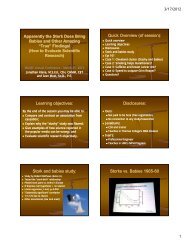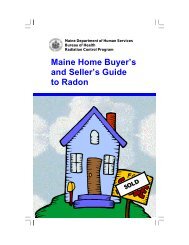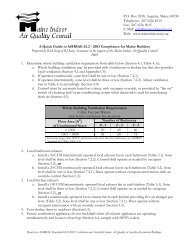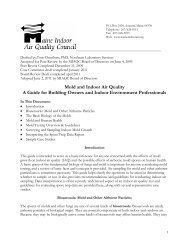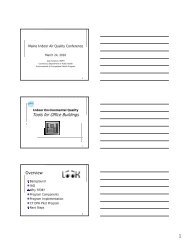Presentation as Handout - Maine Indoor Air Quality Council
Presentation as Handout - Maine Indoor Air Quality Council
Presentation as Handout - Maine Indoor Air Quality Council
- No tags were found...
Create successful ePaper yourself
Turn your PDF publications into a flip-book with our unique Google optimized e-Paper software.
Managing the Risks of PCBs in Renovations and Construction<strong>Maine</strong> IAQ Conference ◊ March 24, 2010Managing the Risks ofPCBs in Constructionand Renovation ProjectsMatt A. Fragala, M.S., C.I.H.Environmental Health & Engineering, Inc.Needham, M<strong>as</strong>sachusetts(800) 825-5343 mfragala@eheinc.comEH&E PCB Caulk Experience• Dealing with PCBs in building materials since1995– 30+ projects involving PCBs in building includinghospitals, office buildings, public schools, universitybuildings, residential buildings• Over 30 miles of caulking replaced© 2010 Environmental Health & Engineering, Inc.PCBs Background• No known natural sources• Commercial PCB mixtures have thetrade name Aroclor• Mixture of up to 209 individualchlorinated compounds known <strong>as</strong>congenersCommon PCB Uses• Coolants• Lubricants• Transformers• Capacitors• CaulkingMatt Fragala, M.S., C.I.H., Senior ScientistEnvironmental Health & Engineering, Inc.www.eheinc.com ◊ 800.825.5343
Managing the Risks of PCBs in Renovations and Construction<strong>Maine</strong> IAQ Conference ◊ March 24, 2010U.S.A. Production• Peak of production in late 60’s – early 70’s• After 1972-73, the production of PCBs w<strong>as</strong>virtually eliminated• 1977 production w<strong>as</strong> banned by EPAbecause of environmental and health effectsMonsanto Production of PCBs000's lbs.Pl<strong>as</strong>ticizer Production (NIOSH 1975)25,00020,00015,00010,0005,00001957195819591960196119621963196419651966196719681969197019711972197319741975YearRegulatory Review• No requirements for identification of PCB-containingbuilding materials• Primary regulated by USEPA under the Toxic Substanceand Control Act (TSCA)• EPA h<strong>as</strong> determined certain non-liquid PCBs present apotential risk to human health and the environment• Materials containing PCBs in concentrations greater than50 ppm (there are specific exemptions) are considered“unauthorized”Definitions 40 CFR §761.3• Excluded PCB Products– Materials with concentrations less than or equal to50 ppm.• PCB Bulk Product W<strong>as</strong>te– w<strong>as</strong>te derived from manufactured products in nonliquidstate, greater than 50 ppm at time ofdisposal.• PCB Remediation W<strong>as</strong>te– w<strong>as</strong>te containing PCBs <strong>as</strong> a result of a spill,rele<strong>as</strong>e, or other unauthorized disposal.Matt Fragala, M.S., C.I.H., Senior ScientistEnvironmental Health & Engineering, Inc.www.eheinc.com ◊ 800.825.5343
Managing the Risks of PCBs in Renovations and Construction<strong>Maine</strong> IAQ Conference ◊ March 24, 2010“UNAUTHORIZED”• Caulking and sealants that contain PCBs inexcess of 50 ppm are examples of productsthat are considered unauthorized by EPA andmust be removedPCB Residues• PCB residues must also be removed fromsurfaces in contact with the caulkingDefinitions 40 CFR §761.3• Non-porous surfaces– “a smooth, unpainted solid surface that limitspenetration of liquid containing PCBs… smoothun-corroded metal… smooth gl<strong>as</strong>s… polishedbuilding stone …”Definitions 40 CFR §761.3• Porous surfaces– “any surface that allows PCBs to penetrate orp<strong>as</strong>s into itself including, but not limited to, paint orcoating on metal; … porous building stone …concrete or cement pl<strong>as</strong>ter… <strong>as</strong>phalt...”Matt Fragala, M.S., C.I.H., Senior ScientistEnvironmental Health & Engineering, Inc.www.eheinc.com ◊ 800.825.5343
Managing the Risks of PCBs in Renovations and Construction<strong>Maine</strong> IAQ Conference ◊ March 24, 2010• PCBs leach intosurroundingsurfaces• More poroussurfaces havegreater matrixpenetrationPCB ResiduesPCB Residue Cost• Residue cleaning is most expensive andinv<strong>as</strong>ive part of a program <strong>as</strong> structuraland aesthetic features may be impactedRecent RemediationProject CostsManage in Place?BuildingTypeUniversityAcademicCommercialOfficeUniversityOfficeUniversityAcademicWorkScheduleVacateddue tooccupantfearsSize(SF)Costs($000,000)80,000 $1.4($3.7 total)Costs/SF($)$18($47)Occupied 260,000 $3.4 $13Unoccupied 155,000 $1.4 $9Occupied 197,000 $2.4 $12• Unlike <strong>as</strong>bestos, the EPA does nothave a “manage in place” regulatoryapproach for these unauthorized PCBproducts.– Once PCBs are identified, they must betaken out of service.• Guidance is available on managing therisk of PCB caulk and potentialexposuresMatt Fragala, M.S., C.I.H., Senior ScientistEnvironmental Health & Engineering, Inc.www.eheinc.com ◊ 800.825.5343
Managing the Risks of PCBs in Renovations and Construction<strong>Maine</strong> IAQ Conference ◊ March 24, 2010Remediation ProcessAlternative Decontamination Plan• Strictly regulated byregional EPA TSCAPCB Coordinator• Property owner cansubmit an “alternativedecontamination plan(79h)” for EPA to reviewand approve• Specifies the nature and extent of therequired remediation work• Remediation methods• Testing and verification procedures• Validation procedures to show the cleanupw<strong>as</strong> successful• State and local authorities are to benotified of ADP§761.79(h) Alternative Decontamination• Any person wishing to decontaminate material described inparagraph (a) of this section in a manner other than prescribed inparagraph (b) of this section must apply in writing to the EPARegional Administrator…• Any person wishing to decontaminate material described inparagraph (a) of this section using a self-implementation procedurein a manner other than prescribed in paragraph (b) of this sectionmust apply in writing to the EPA Regional Administrator…• Any person wishing to sample decontaminated material in a mannerother than prescribed in paragraph (f) of this section must apply inwriting to the EPA Regional Administrator…EPA Region One• PCB Coordinator is Ms. Kimberly Tisa• Region One Headquarters is b<strong>as</strong>ed inBoston and covers New England• EPA may request additional information that it believes necessary toevaluate the application.• EPA will issue a written decision on each application for risk-b<strong>as</strong>eddecontamination or sampling. No person may conductdecontamination or sampling under this paragraph prior to obtainingwritten approval from the EPA.Matt Fragala, M.S., C.I.H., Senior ScientistEnvironmental Health & Engineering, Inc.www.eheinc.com ◊ 800.825.5343
Managing the Risks of PCBs in Renovations and Construction<strong>Maine</strong> IAQ Conference ◊ March 24, 2010State and Local Authorities• Limited jurisdiction• If there is a “rele<strong>as</strong>e” resulting inenvironmental contamination (soil), theState DEP regulations could betriggered.• Similar to hazardous w<strong>as</strong>te site cleanupwith removal, disposal, andreplacement fill.Remediation Process• B<strong>as</strong>ed on our experience we havedefined a strategy that is broken downinto five stages of workPCB Remediation Strategy5 Steps1. Building Characterization2. Remediation Plan Development3. Pilot Remediation Program4. Remediation Program5. Testing and VerificationBuilding Characterization• Determine the nature and extent of PCBcaulking in a building• Sampling suspect caulking materials• Characterizing the levels of PCBs insurrounding materialsMost Important Stage!Matt Fragala, M.S., C.I.H., Senior ScientistEnvironmental Health & Engineering, Inc.www.eheinc.com ◊ 800.825.5343
Managing the Risks of PCBs in Renovations and Construction<strong>Maine</strong> IAQ Conference ◊ March 24, 2010Building Characterization• Five buildings– Tower A (1972)– Low-rise (1972)– Tower B (1974)– Tower C (1974)– Polymer Building(1990)Building CharacterizationPCBCaulkNon-PCBCaulk$1.5-2 M saved in remediation costsBuilding Characterization• Caulking or g<strong>as</strong>ket material in contact with thealuminum window frames– Aroclor 1254 pattern– Range: BRL to 33,000 ppm (n = 9)Building Characterization• G<strong>as</strong>ket material in contact with window panes– Aroclor 1254 pattern– Range: 110 to 4,300 ppm (n = 18)Matt Fragala, M.S., C.I.H., Senior ScientistEnvironmental Health & Engineering, Inc.www.eheinc.com ◊ 800.825.5343
Managing the Risks of PCBs in Renovations and Construction<strong>Maine</strong> IAQ Conference ◊ March 24, 2010Substrate Depth Profiling forPCB ContaminationRemediation Plan Development• How caulking will be removedPCBConcentrationdecre<strong>as</strong>es withdistance• How surrounding surfaces will bedecontaminated• Containment me<strong>as</strong>ures• Verification programRemediation Goals• Removal of PCB-containing materials in <strong>as</strong>taged f<strong>as</strong>hion• Protect workers, occupants, andenvironment– Restricted access– Containment isolation barriers– Pressurization relationships– Routine air samplingProtect The Ground• Ground cover is criticalduring the remediationprocess• If necessary, clean-up ofsoil will occur after buildingabatementMatt Fragala, M.S., C.I.H., Senior ScientistEnvironmental Health & Engineering, Inc.www.eheinc.com ◊ 800.825.5343
Managing the Risks of PCBs in Renovations and Construction<strong>Maine</strong> IAQ Conference ◊ March 24, 2010Removal Porous Surface• Cutters with localexhaust captureHEPA filtrationRemoval Non-Porous Surface• Metal windowframe in contactwith PCB caulking• Scraping anddamp wiping withsolventPorous Verification Samples• Core samples taken fromconcrete joints• Core samples below 1ppm(first floor) and below 25ppm (other floors)• If sample fails, area andpreceding are<strong>as</strong> will needto be re-cleaned and retestedNon-Porous Verification Samples• Wipe samples taken frommetal frames• Wipe samples need to bebelow 10 µg/ 100 cm 2 (firstfloor) and below 100 µg/100 cm 2 (other floors)• If sample fails, area andpreceding are<strong>as</strong> will needto be re-cleaned and retestedMatt Fragala, M.S., C.I.H., Senior ScientistEnvironmental Health & Engineering, Inc.www.eheinc.com ◊ 800.825.5343
Managing the Risks of PCBs in Renovations and Construction<strong>Maine</strong> IAQ Conference ◊ March 24, 2010Pilot Remediation ProgramRemediation Programs• Remediation contractor conducts <strong>as</strong>mall scale remediation in accordancewith plan• Testing conducted to determineproposed methods will be effective• Methods are refined to meet objectivesTesting and Verification• Sampling and visual inspection to documentcaulking and residues have been removed• Final project closeout report that includes allproject related information and testing data• EPA SubmittalClean-up Criteria• Porous surfaces– Unrestricted use: ≤ one part per million (ppm)– Low-occupancy are<strong>as</strong>: ≤ 25 ppm, but requiresdeed restriction• Non-porous surfaces– Unrestricted use: ≤10 micrograms per 100 squarecentimeters (10 µg/100 cm 2 )– Low-occupancy are<strong>as</strong>:
Managing the Risks of PCBs in Renovations and Construction<strong>Maine</strong> IAQ Conference ◊ March 24, 2010Potential Impacts of Remediation• Potential closure of the building• Displacement of occupants• Unplanned budget expenditures ($) forremediation and capital improvements• Fear and uncertainty among building occupantsand the general public in the face of unknownhealth risks and environmental impactsManagement Options• Current regulations do not leave manyoptions for building owners• Once identified unauthorized PCBcaulking must be removed• No specific timeframe is identified in theregulations• Expectation is “<strong>as</strong> soon <strong>as</strong> fe<strong>as</strong>ible”Timing Factors• Occupancy disruption• Financing• Weather conditionsDeed Restriction• Building owner may elect to leave higherresidual concentrations of PCBs in place if theyare will to accept a deed restriction on theproperty– This option needs approval of EPA• Reduces effort and expense but creates al<strong>as</strong>ting restriction on the property– May be an option for owner-occupiedpropertiesMatt Fragala, M.S., C.I.H., Senior ScientistEnvironmental Health & Engineering, Inc.www.eheinc.com ◊ 800.825.5343
Managing the Risks of PCBs in Renovations and Construction<strong>Maine</strong> IAQ Conference ◊ March 24, 2010Conclusions• PCBs can be found indoors from buildingmaterials; testing confirmation of PCBs triggersregulatory notification and remediation• Concentrations of source material may exceedcurrent Federal regulatory limits (50 ppm)• Building age is a critical determinant to PCBcontaminationConclusions• Review building specifications and construction isto <strong>as</strong>sess risk and extent of PCB contamination– The risk of PCB caulk in buildings can be managed tomitigate occupant exposures• Contractors should be aware of PCB caulk andpotential liabilities regarding worker exposure anddisposalConclusions• PCB caulk and building materials can besuccessfully remediated to meet EPA’srequirements• Considerable efforts in occupant health riskcommunications must be planned andundertaken throughout the projectManaging the Risks ofPCBs in Constructionand Renovation ProjectsMatt A. Fragala, M.S., C.I.H.Environmental Health & Engineering, Inc.Needham, M<strong>as</strong>sachusetts(800) 825-5343 mfragala@eheinc.com© 2010 Environmental Health & Engineering, Inc.Matt Fragala, M.S., C.I.H., Senior ScientistEnvironmental Health & Engineering, Inc.www.eheinc.com ◊ 800.825.5343




